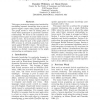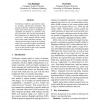151 search results - page 3 / 31 » Cross-Cutting Models of Lexical Semantics |
ACL
2003
13 years 6 months ago
2003
Traditional vector-based models use word co-occurrence counts from large corpora to represent lexical meaning. In this paper we present a novel approach for constructing semantic ...
COLING
2002
13 years 4 months ago
2002
This paper presents an unsupervised method for assembling semantic knowledge from a part-ofspeech tagged corpus using graph algorithms. The graph model is built by linking pairs o...
ACL
2010
13 years 2 months ago
2010
We argue that groups of unannotated texts with overlapping and non-contradictory semantics represent a valuable source of information for learning semantic representations. A simp...
NAACL
2010
13 years 2 months ago
2010
Coreference resolution is governed by syntactic, semantic, and discourse constraints. We present a generative, model-based approach in which each of these factors is modularly enc...
NAACL
2010
13 years 2 months ago
2010
Current vector-space models of lexical semantics create a single "prototype" vector to represent the meaning of a word. However, due to lexical ambiguity, encoding word ...


